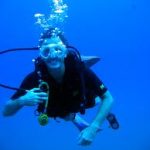“Buoyancy Control? Simply allow people to learn” – PADI Course Director

Buoyancy Control and Trim
Have you noticed how new divers on a Discover Scuba Diving program happily swim around in mid-water? Without any knowledge of buoyancy control, they just have fun. It doesn’t take long for them to adjust to a new 3 dimensional environment, especially if their mind is occupied by Frisbees and other underwater toys. Modern Instructors have certainly noticed that these new divers are … well, diving! So when introducing new skills on an open water course it just doesn’t make any sense to stop them from diving and then anchoring them to the floor.

Trim is so important

You can involve the students to achieve this. You’ll have already discussed the importance of good trim in the classroom. Ask them to swim around. Give them some spare weights with clips on. They can act as buddy pairs clipping weights onto different parts of each other’s equipment until they’re comfortable. The trim of the new diver is probably the single most important factor that modern instructors concentrate on right at the beginning of each session so that divers can be comfortable and learn new skills naturally.
Some skills like mask clearing are a bit more complex. Divers have to concentrate on different sub skills. Allowing water in, looking slightly upward, breathing in through the mouth, and then out through the nose. All the time touching the top of the mask to encourage the water to leave the mask. It’s a bit much to ask student divers to attempt this while swimming around. But there is no reason why they can’t be resting on their fin tips, legs apart for stability, while they concentrate on clearing their mask. It’s fine for them to be leaning forward, just like they would be when diving. Once they’ve successfully cleared their mask a few times, they can then be encouraged to swim around and clear their mask again and again while moving around in mid water.
I’ve got another video on YouTube that concentrates on the importance of effective practice, and how Instructors can allow people to learn.
For the last couple of years I’ve focused a lot more on buoyancy during my IDCs. My candidates have had a lot of fun practicing skills while neutrally buoyant. They’ve performed teaching presentations while neutrally buoyant in front of the PADI Examiners during their Instructor Exam, and of course they have taken these practices back to their dive centres. They tell me that students love being taught in this manner, and when they get to Open Water, there is very little need for any platform, or sandy bottom to settle on to perform skills.
If you’d like to know more about my teaching, or would like to attend any of my courses Please contact me now

